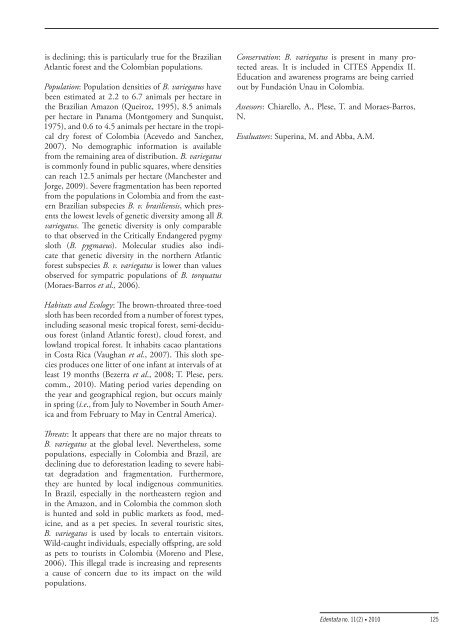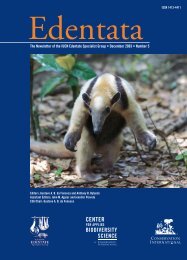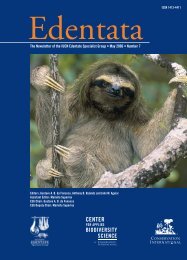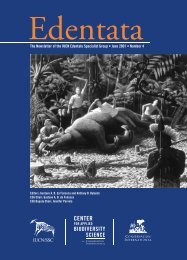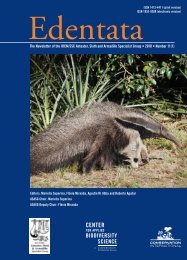Edentata 11(2), 2010 - Anteater, Sloth & Armadillo Specialist Group
Edentata 11(2), 2010 - Anteater, Sloth & Armadillo Specialist Group
Edentata 11(2), 2010 - Anteater, Sloth & Armadillo Specialist Group
- No tags were found...
You also want an ePaper? Increase the reach of your titles
YUMPU automatically turns print PDFs into web optimized ePapers that Google loves.
is declining; this is particularly true for the BrazilianAtlantic forest and the Colombian populations.Population: Population densities of B. variegatus havebeen estimated at 2.2 to 6.7 animals per hectare inthe Brazilian Amazon (Queiroz, 1995), 8.5 animalsper hectare in Panama (Montgomery and Sunquist,1975), and 0.6 to 4.5 animals per hectare in the tropicaldry forest of Colombia (Acevedo and Sanchez,2007). No demographic information is availablefrom the remaining area of distribution. B. variegatusis commonly found in public squares, where densitiescan reach 12.5 animals per hectare (Manchester andJorge, 2009). Severe fragmentation has been reportedfrom the populations in Colombia and from the easternBrazilian subspecies B. v. brasiliensis, which presentsthe lowest levels of genetic diversity among all B.variegatus. The genetic diversity is only comparableto that observed in the Critically Endangered pygmysloth (B. pygmaeus). Molecular studies also indicatethat genetic diversity in the northern Atlanticforest subspecies B. v. variegatus is lower than valuesobserved for sympatric populations of B. torquatus(Moraes-Barros et al., 2006).Conservation: B. variegatus is present in many protectedareas. It is included in CITES Appendix II.Education and awareness programs are being carriedout by Fundación Unau in Colombia.Assessors: Chiarello, A., Plese, T. and Moraes-Barros,N.Evaluators: Superina, M. and Abba, A.M.Habitats and Ecology: The brown-throated three-toedsloth has been recorded from a number of forest types,including seasonal mesic tropical forest, semi-deciduousforest (inland Atlantic forest), cloud forest, andlowland tropical forest. It inhabits cacao plantationsin Costa Rica (Vaughan et al., 2007). This sloth speciesproduces one litter of one infant at intervals of atleast 19 months (Bezerra et al., 2008; T. Plese, pers.comm., <strong>2010</strong>). Mating period varies depending onthe year and geographical region, but occurs mainlyin spring (i.e., from July to November in South Americaand from February to May in Central America).Threats: It appears that there are no major threats toB. variegatus at the global level. Nevertheless, somepopulations, especially in Colombia and Brazil, aredeclining due to deforestation leading to severe habitatdegradation and fragmentation. Furthermore,they are hunted by local indigenous communities.In Brazil, especially in the northeastern region andin the Amazon, and in Colombia the common slothis hunted and sold in public markets as food, medicine,and as a pet species. In several touristic sites,B. variegatus is used by locals to entertain visitors.Wild-caught individuals, especially offspring, are soldas pets to tourists in Colombia (Moreno and Plese,2006). This illegal trade is increasing and representsa cause of concern due to its impact on the wildpopulations.<strong>Edentata</strong> no. <strong>11</strong>(2) • <strong>2010</strong> 125


